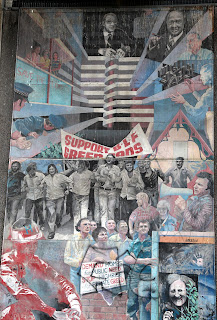 |
The Location Wooloomooloo is the bay to the East of Farm Cove, on the very edge of the first settlement. It is peopled with those who cannot afford to live elsewhere, but who huddle trapped between a precipitous rocky escarpment, the edge of the harbour, and a small stream being rapidly fouled.
The A Team A combination of the landed political class, property developers, and corrupt coppers (Robin Askin, Frank Theeman, Joe Meisner, Norm Gallagher were notable)
The B Team Residents, unionists, leftist progressive politicians, academics, and journalists (Jack Mundey, Joe, Owens, Juanita Neilsen, Tom Uren, Gough Whitlam)
 |  |
What happened? The city was bursting at the seams. More office space was required. More high rise residential buildings were required. And here, on the edge of the city, was a valley full of run-down tenement houses, terraces jumbled together as they tumble down the escarpment. Hovels rented to the working class, the criminal class, the unemployed and those on the drug or sex game.
This was the time when Paddington was discovered by the artists who moved into the rundown terraces and a flowering occurred, saving the area. The ‘Loo was closer to the city, and the elite were mendacious. They bought up terrace after terrace, allowing entire blocks to become rundown and rat infested. They waited. They planned. They plotted.
But the residents protested. Loudly. They called in reinforcements in the form of two unions: the Builders Labourers Federation (BLF); and the Federated Engine Drivers’ and Firemen’s Association (FEDFA). Developers brought in strike-breakers, and violence ensued. People were bashed and kidnapped, police evicted squatters, and Juanita Neilson, the editor of a local newsletter, disappeared. The ‘Green Ban’ was born.
Such bans were springing up all over the city, not just the inner city. They were imposed in The Rocks, down near the bridge, and in Kellys Bush on the north of the harbour. A ‘green ban’ is not just the saving of trees, but also of green space, of breathing space, of room to move. Unions simply refused to knock down the old buildings. Refused to operate the machinery of destruction. Marched to the sound of megaphones. Lay down in front of cranes and dozers. Chained themselves to fences and railings.
From 1971 to 1974 42 green bans were applied by the BLF at the behest of resident activists.
 |
Tomorrow, I will end this series with a post about the area as it is today.
10 comments:
These are great Julie.
Wow, Julie. What happened to the newspaper editor? You say she disappeared. Was she ever found? (You can tell where my priorities lie.)
Fascinating recent (to me) history. Looking forward to more.
K
Nope never found from that day to this. They found some belongings scattered along a freeway on the other side of the city. Lomg and involved coroners inquest in the early 80s declared to have been probably murdered.
That is a rough bunch you have down there.
A very interesting history lesson. I was busy having babies and living on the edge of civilisation near Brisbane when this was going on. I only vaguely remember these incidents.
BTW I need your help to answer a question on my Taphophile post.
I remember the hoo haa but not the detail. And not knowing Sydney I didn't know if what they were fussing about was worth saving. Up in Brisbane Joh sent in wreckers over night to clear away the building he wanted gone.
It is pretty much in the eye of the beholder, Joan. It was very much a them vs us era, rich vs poor, developers vs activists. Much of what is there now is in a sorry state, and I think the battle will rage all over again in another 50 years.
These are great murals and I definitely love the name Wooloomooloo!
It is a formative period of Sydneys history that led up to what was then ground breaking planning legislation - the Environmental Planning and Assessment Act 1979 - only now undergoing a serious review.
Im looking forward to tomorrows post.
The next post is a little delayed; I ran out of energy last night. But I am sitting on Broadmeadows station waiting for the very late XPT so shall try to write it.
I agree about the Planning Laws and how this changed everything. I am not all that hopeful of the review that BOF plans. Not off to an auspicious start with all the umms and ahhs. However, the state of play between developers and public policy during the previous 15 years was appalling.
Post a Comment